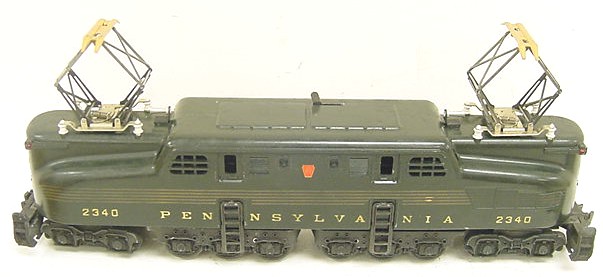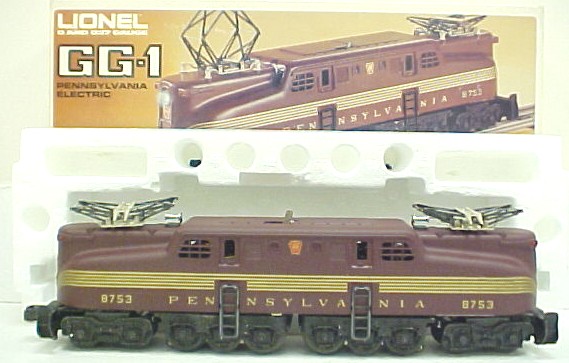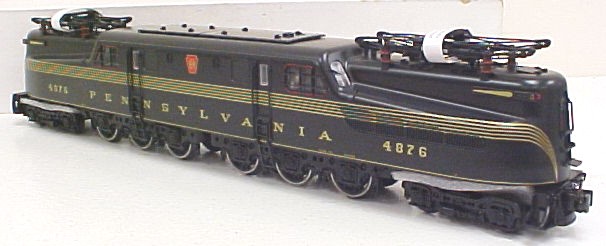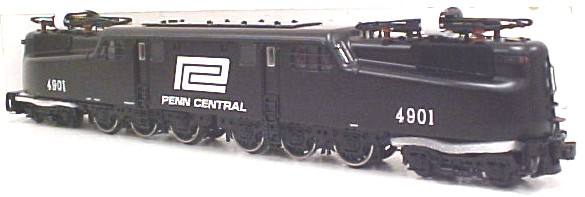The

Guide to:

Lionel GG-1 Electrics
Since 1947, the GG-1 electric locomotive has been a staple item in Lionel's product line. While the general appearance of the engine only changed slightly for 50+ years, the GG-1 has been produced in a variety of paint schemes and with many internal changes.
In this article we will briefly describe each of Lionel's 24 different GG-1s, the characteristics of each model, and the relative rarity of each item.
Lionel's Inspiration
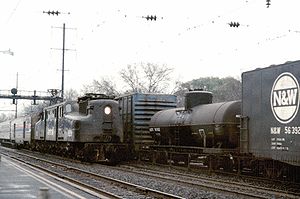
(Photo courtesy of Wikipedia.org)
The GG-1 was the culmination of the Pennsylvania Railroad's search for a high-speed, high-horsepower locomotive to operate on its Washington-New York main line, which was in the process of being completely electrified in the mid-1930s. The first GG-1 was built in 1934, just a year before the electrification project was completed.
The GG-1 was a cross between the existing P-5 electrics then being used by the PRR and the EP-3 electrics owned by the nearby New Haven railroad. A total of 139 GG-1s were built between 1934 and 1943.
With top speeds of over 100 mph and the ability to generate up to 8000 horsepower, the GG-1 was a marvel of its time. In his book 'Pennsy Power', Alvin Staufer credits the electrification of PRR's eastern lines, and the GG-1 in particular with keeping the railroad's massive traffic surge moving during World War II. After the war, the GG-1 continued to form the backbone of Pennsy's electric passenger power, and as passenger ridership started to decline in the late 1950s, the GG-1s began to gravitate to freight work.
The first GG-1s were retired in the mid-1960s, and they passed from the Pennsylvania to Penn Central, Conrail and Amtrak during the late 1960s and 1970s. All were retired by 1984. A surprising 16 remain in existence, spread around various railroad museums throughout the eastern United States.
|
Why 'GG-1'?? The name 'GG-1' is derived from the Pennsylvania's locomotive identification system. Like most railroads of the time, the PRR assigned letters to steam locomotive wheel arrangements-for example, 'A' was used for 0-4-0s, 'K' for 4-6-2s, and 'I' for 2-10-0s. 'G' was Pennsy's standard designation for a 4-6-0. The railroad applied the steam designations to its electrics, and the railroad considered the GG-1's 4-6-6-4 arrangement to actually be two 4-6-0s coupled back to back. Thus, 'GG-1' was born. There was no 'GG-2'; the Pennsylvania was perfectly happy with the design and never sought to redesign or enhance the engine during its production run.
|
Lionel's Models
Postwar Era GG-1s
Lionel's first GG-1 was catalogued in 1947, and three more models followed during the 1950s. The GG-1 was catalogued in the Postwar Era in 1963.
The first--#2332 (1947-49)
In 1947 the 2332 joined Lionel's roster at the head of a set including three Madison-type passenger cars. In 1948 and 1949 the GG-1 was also catalogued with freight cars.
The 2332 is unique for several reasons. First, it is the only Lionel GG-1 with one motor. Also, it has a horn unique to this engine. Unlike all other Postwar-Era Lionel engines whose horn is a door alarm powered by a D-cell battery, the 2332 has a plastic box with a small peg inside of it, which vibrates when activated by the whistle controller on the transformer.
Because of its three-year production run, the 2332 is a relatively common engine as GG-1s go. The 2332 also has many minor variations, due to running changes made by Lionel during the early parts of the production run.
Many 2332s have been restored. This is because the lettering was all applied using a rubber stamp, and over the years exposure and handing have slowly rubbed the stripes off. A 2332 with complete, intact stripes is rare. Also, many have been restriped but not relettered.
An original 2332 will usually have 'weaker' striping around the middle of the engine, in the places where the engines are usually picked up and held. If the stripes are perfect and the engine is being advertised as original, great caution is recommended.
The engine pictured above is the finest original 2332 we have had at Trainz.com.
#2330 (1950)

In 1950 Lionel completely redesigned the GG-1, giving it two motors and the same horn found in its popular F-3 diesels. This new and improved GG-1 also received Lionel's Magnetraction feature, also introduced in 1950. The model also got a new number, 2330.
One of the most powerful Postwar engines ever made, the 2330 and the other dual-motored GG-1s can pull a enormous number of cars.
Included in only one set for one year, the 2330 is the rarest of the Postwar GG-1s. The 2330's instruction sheet is also unique, as it is one of the few Postwar-era sheets with an actual picture of the locomotive instead of a drawing.
Like the 2332, many 2330s have been restriped. However, unlike the 2332, the 2330s numbers and letters were heat-stamped, so they usually hold up quite well.
Also be aware that 2330s can suffer battery damage, if the D cell that powers the horn was left inside the engine. The battery is located on the end, so check around the front and rear trucks carefully.
#2340-1 and #2340-25 (1955)
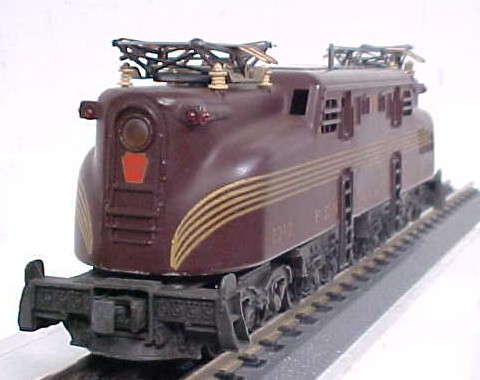
After 1950, Lionel dropped the GG-1 and did not reintroduce it until 5 years later. Mechanically identical to the 2330, the new 2340 was available in two color schemes-Tuscan red with gold stripes (2340-1) and green with gold stripes (2340-25). The tuscan model was sold with a matching set of 4 aluminum passenger cars [this is the famous Lionel 'Congressional' set], and the 2340-25 headed up a freight set.
2340s are seen a bit more often than 2330s but are still hard to find. While the tuscan model is more prized by most collectors, we actually see the green model less often.
Both engines were dropped after one year.
Like the 2330, many 2340s have been restriped. Also be aware that 2340s can suffer battery damage, if the D cell that powers the horn was left inside the engine. The battery is located on the end, so check around the front and rear trucks carefully.
#2360 (1956-63), and 2360-25 (1956-58)
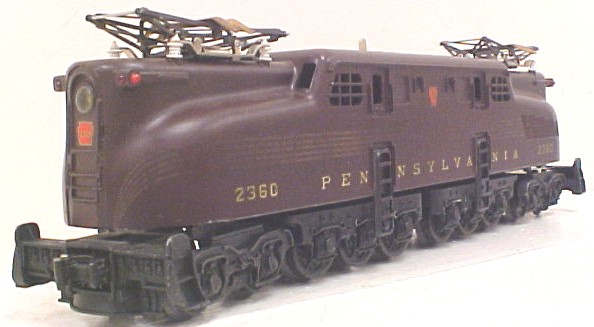
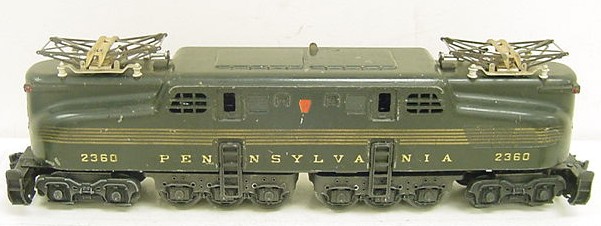
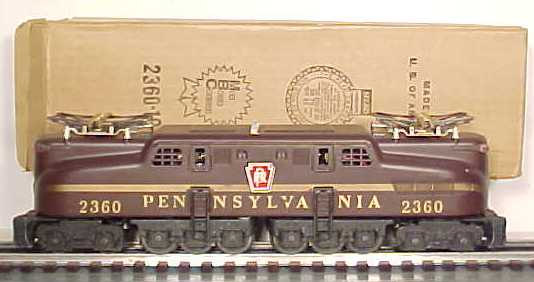
In 1956 the GG-1 received a new number, 2360. For the first three years the engines were essentially repeats of the 2340s, with the only significant change being the numbers. Like the 2340, the 2360-1 was a tuscan model, and the 2360-25 was green. But in 1959, the green 2360 was dropped, and the tuscan model's paint scheme was altered to match the Pennsylvania's new paint style, with a single stripe down the side replacing the previous five stripe appearance.
The 2360 soldiered on for five more years, heading up a variety of freight and passenger sets. At the very end of the production run the method for applying the stripes and lettering was changed, with decals being used in place of rubber stamping. As a result, the decoration of late GG-1s have a distinctive decal sheen around them.
The early 2360s with five stripes and the later single-stripe version with decals are the hardest to find, with the stamped single stripe models being most common. The green 2360-25 seems to be a particularly hard model to find. Of the 17 2360s we have had at Trainz since 2005, only two have been 2360-25s.
Like the 2330 and 2340, many five-stripe 2360s have been restriped. The single-stripe 2360s hold up very well over time, and the great majority of them are still original.
Also be aware that 2360s can suffer battery damage, if the D cell that powers the horn was left inside the engine. The battery is located on the end, so check around the front and rear trucks carefully.
MPC-Era GG-1s
After 1963, the GG-1 went into hibernation for 14 years. During that time General Mills and its subsidiary Model Products Corporation [MPC] took over Lionel's train production in 1969-1970. Focusing on basic models at first, the MPC team became more daring as the 1970s wore on, and by 1977 they felt ready to bring back the GG-1.
#8753 (1977)
The first of the reissued G's was a mild success. Essentially the same as the 2360, but without a horn, the 8753 sported two motors and Magnetraction. But the tuscan color was a bit off, and the striping was not as crisp as that seen on Postwar GG-1s. Also, the engine uses plastic gears in place of brass and metal gears used on all other GG-1s.
#8850 (1978)
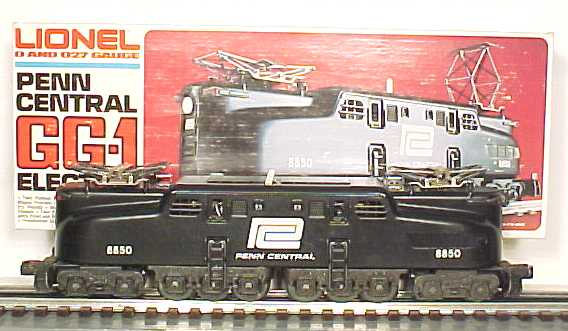
The following year Lionel corrected the mechanical problems, installing metal gears in the new model, #8850. Lionel also broke new ground by offering the GG-1 in Penn Central colors, marking the first time the GG-1 was not made in Pennsylvania markings.
Actually, Penn Central 'color' might be more descriptive, as the engine had a dull, all-black appearance. The 8850 was not a fast seller, and many were repainted. It's a shame, as the 8850 is a great pulling engine, and the stark PC paint scheme has a unique allure all its own. It could be that the Penn Central's bankruptcy in the 1970s soured the reception of the engine's release.
#8150 [4935] (1981)

Three years later, Lionel took another shot at the GG-1, returning to Pennsylvania colors, producing the #8150 in green with gold stripes. The green was painted with a gloss-enamel finish, giving the locomotive a polished appearance. It was also the first GG-1 with a prototypical number, 4935, the number of the GG-1 preserved at the Railroad Museum of Pennsylvania in Strasburg.
The 8150 is mechanically identical to the 8850 and can pull a tremendous number of cars.
Of the three MPC-era GG-1s, the 8150 is worth slightly more than the 8753 and 8850. Recent releases of GG-1s have lowered the values of all three engines.
Modern-Era GG-1s
In 1986 Detroit real estate mogul Richard Kughn bought the Lionel train business from General Mills. A longtime collector himself, Kughn sought to return Lionel to its glory days. This meant bringing back the great engines of Lionel's past, and this included the GG-1.
#18300 (1987)
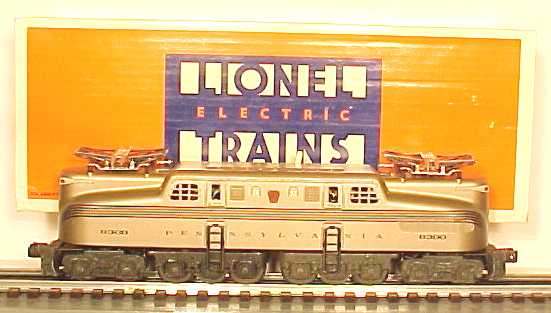
The first Modern-Era GG-1 was the 18300. Often called the 'Mint GG-1', this one had a unique gold/bronze finish and was designed to head up Lionel's series of mint cars. Mechanically identical to the 8150, the 18300 was, like all MPC-era GG-1s, a limited production item, and like the MPC-era Gs the 18300's value has declined in recent years. Operationally, like all other Lionel GG-1s it is a great running model, but we have heard from operators that this engine has an extended breaking-in time, which is important to remember if you ever purchase an unused model.
#18303 (1989)

Two years after the 18300, the 18303 Amtrak GG-1 was produced, pulling a matching set of 7 cars. Another dual-motor, magnetraction-equipped model, the Amtrak 18303's unique paint scheme is a standout, and it looks great at the head of its matching cars.
Both the 18300 and 18303 have held their values relatively well compared to some other modern-era GG-1s. This may be in part to their unique paint schemes, which have not been repeated by Lionel.
#18308 (1992)
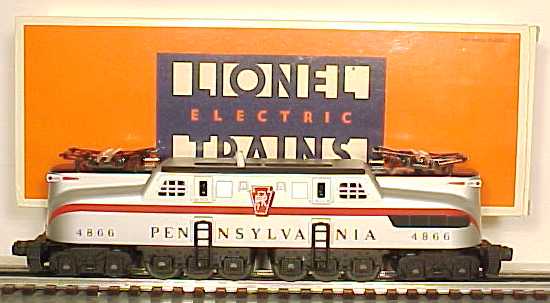
In 1992 the GG-1 made another appearance, this time in a sharp silver and red-stripe combination. This paint scheme does have a prototype-the Pennsylvania applied it to a couple engines while experimenting with new decoration styles in the 1950s.
Like the 18300 and 18303, the 18308 has dual motors and Magnetraction. Perhaps because it was made without any matching cars, or the fact that newer, larger engines were beginning to overshadow the GG-1 at this time, the 18308 is much less common than the 18300 or 18303. In terms of value, however, it is about the same.
#18313 [4907] (1996)
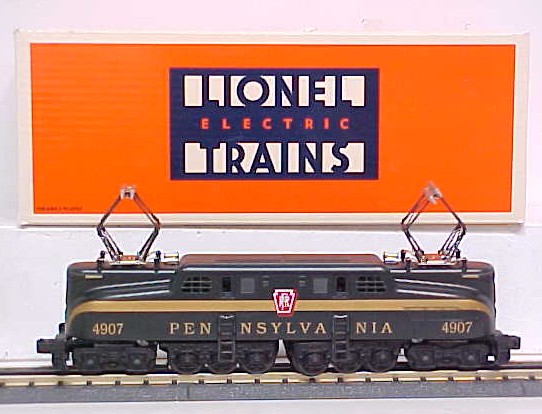
In 1996 Lionel offered two GG-1s. The first, 18313, was the first GG-1 equipped with Lionel's new Trainmaster Command Control system, which allows for the operation of multiple trains at one time on one track, using one controller. It is one of the very few Lionel locomotives equipped with TMCC but no sounds. Like the 18308, the 18313 received a prototypical number--4907.
It's other characteristics are similar to the previous GG-1s. This was the first Lionel GG-1 produced in green with a single stripe, depicting the later paint scheme used by PRR in the late 1950s and 1960s [all previous green GG-1s had 5 stripes].
#18314 [#2332] (1996)
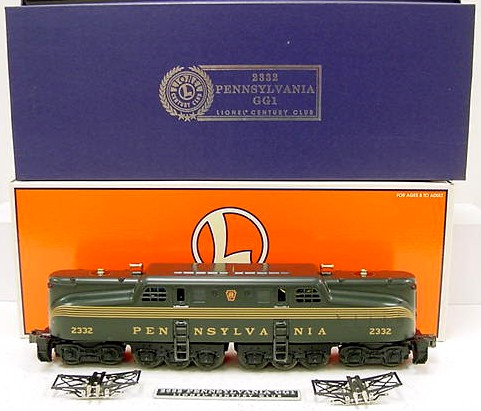
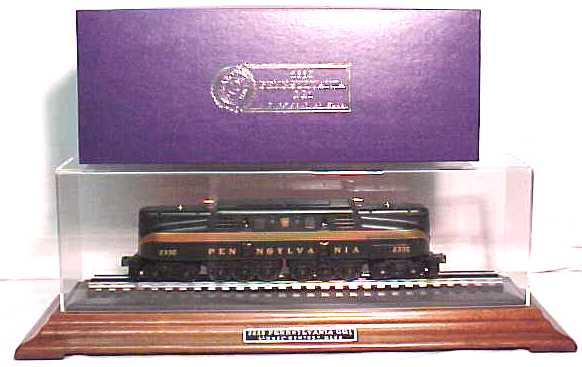
The other GG-1 from 1996 was part of a special release commemorating Lionel's Centennial. Called the Century Club, it consisted of reissues of five classic locomotives from Lionel's Postwar era. They were the #671 turbine, #726 Berkshire, #773 Hudson, #2333 New York Central F-3 AA, and the #2332 GG-1.
While it is very similar to the original 2332 in appearance, under the shell the 18314 is state of the art. This engine features TMCC, Railsounds [the first sound-equipped GG-1 since the 2360] dual motors, and magnetraction.
This engine was also sold with a special display case and paperwork which consisted of a certificate of authenticity and original blueprints of the model.
The Century Club was very popular. Ironically, today the limited-edition 18314 is easier to find than the 18313, which was included in the regular catalog.
#18326 [#2340] (2000)
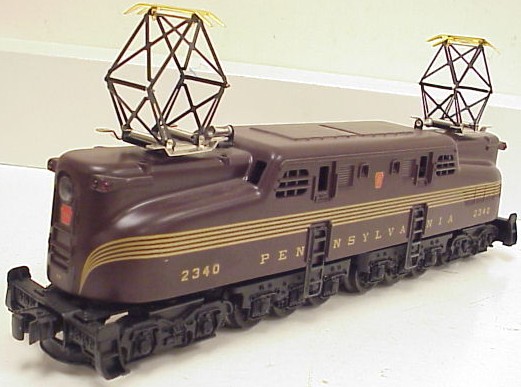
The next GG-1 was part of a special set in the Postwar Celebration Series. This is an ongoing line of reissues of popular Lionel pieces from the 1940s, '50s, and '60s. In 2000 Lionel produced set #21782, which was a rerun of the famed Congressional Limited set from 1955-56. Heading up this set was GG-1 #18326, which was numbered 2340 on the shell and had the sharp tuscan-and-5-stripes motif.
Like the 18314 from 1996, the 18326 is externally similar to the 2340, but internally it has all advanced features with Railsounds, TMCC, dual motors and magnetraction.
Popular but expensive, the Congressional sold well, but the engine is rarely found broken away from the set.
#18343 (2001)
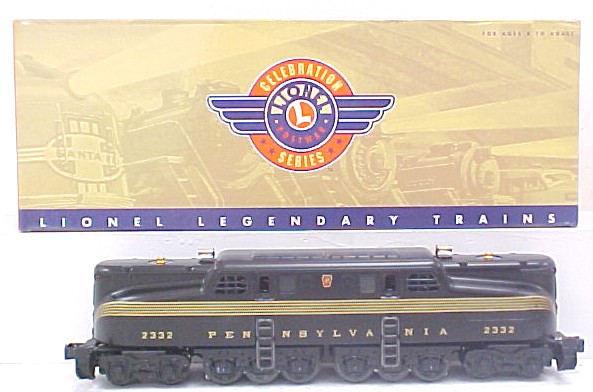
Another member of the Postwar Celebration Series, the #18343 is a is a reissue of the 2332 and is very similar to the 18314 from 1996. The primary difference is that the 18343 is black, vs. the dark green of the 18314. It has the same mechanical features as the 18314, with TMCC, Railsounds, dual motors, and magnetraction.
Perhaps because it was the fifth Pennsy GG-1 made in less than a decade, the 18343 sold a bit slower than some of its predecessors.
The 18343 would be the last GG-1 Lionel made using the Postwar-era design for several years. When the GG-1 returned three years later, it would be a radically different model.
#18354 [4916] (2004)
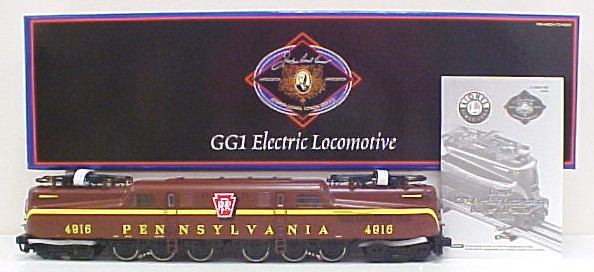
As Lionel's second century began, the company started to move towards making more scale-proportioned models in response to increased competition from companies such as MTH, Weaver, and 3rd Rail. Early in the decade Lionel launched the “Joshua Lionel Cowen” series, a group of highly-detailed, top-of-the-line locomotives that broke new ground in terms of their realism and operation. It was only natural that the famed GG-1 would be a part of this new venture.
The 18354 was the first of three different GG-1s introduced in 2004. Scale length, with a level of detail never before seen on a Lionel G, the 18354 is a stunning model that captures the sleek but hulking size of the GG-1 perfectly. It is fully loaded with TMCC, Railsounds, dual motors, and highly detailed trucks and pantographs. It was also given a prototypical number, 4916, and was painted in the tuscan-and-single-stripe scheme used on PRR GG-1s in the late 1950s and 1960s.
#18355 [4876] (2004)
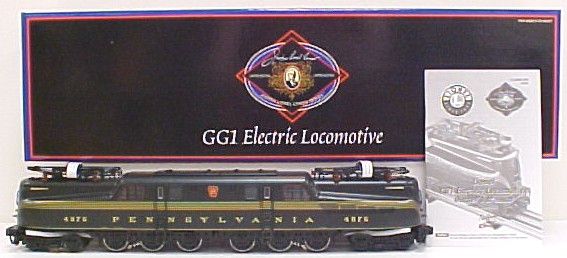
Mechanically identical to the 18354, the 18355 is painted in the classic dark green with 5 stripes and numbered 4876. Based on the number of 18350-series Gs we have seen at Trainz, the 18355 appears to have been the best-selling of the three 2004 engines.
#18356 [4901] (2004)

The third of the three new GG-1s was the 18356, painted in Penn Central's all black scheme and numbered 4901. Like the previous Penn Central GG-1 of the '70s, the 18356 sold slower than its partners.
#18371 [4912] (2005)

The following year, Lionel produced three more scale-length Gs for the Joshua Lionel Cowen Series. The first was #18371, painted in tuscan with 5 stripes.
#18372 [4925] (2005)

Also in '05, the GG-1 was produced in a green with single stripe scheme, which is the motif used on PRR GG-1s assigned to freight duty in the late 1950s and '60s.
#18374 [4866] (2005)

The third GG-1 in 2005 was decorated in the sharp silver, black and red scheme similar to that used on the 18308 GG-1 in 1992. Like the 18308, the 18374 appears to have been a slow seller, perhaps because many collectors believe it is not an authentic PRR paint scheme. Actually it is, as the Pennsy applied it to a couple engines while experimenting with new decoration styles in the 1950s.
#38301 [2332] (2009)

With six massive and expensive GG-1s hitting the market within two years, it appeared that Lionel would give the famous model a break, and indeed they have-no command equipped or scale-sized GG-1 has been catalogued since the 18371-74 models. But in late 2008, Lionel announced the return of the GG-1 in a new, lower-priced Postwar reissue series, called the Conventional Classics.
The Conventional Classics are similar to the Postwar Celebration Series in that they are reissues of popular models from the 1940s and '50s. Unlike the Celebration Series, however, the Conventional Classics do not have command control or Railsounds [they do have a horn, however], and are intended to be operated using the same control methods used with Postwar-era trains. Internally the Conventional Classics do have modern features such as circuit boards.
The 38301 is a reissue of the 2332 [the third 2332 reissue since 1996] and heads up the 31777 '2124W' passenger set, which is a remake of the original 2332 set from 1947. Externally it is very similar to the 18343 from 2001.
#38303 [2340] (2009)

Along with the 38301, Lionel also released the 38303, which is painted in the tuscan and five stripe scheme used on the Congressional Limited GG-1s. It is numbered 2340 on the side and is very similar in outward appearance to the 18326 from 2000.
Both Conventional Classics were hot sellers, thanks to their affordable price and great looks.
Boxes and Packaging
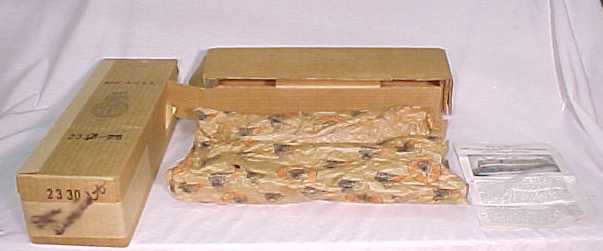
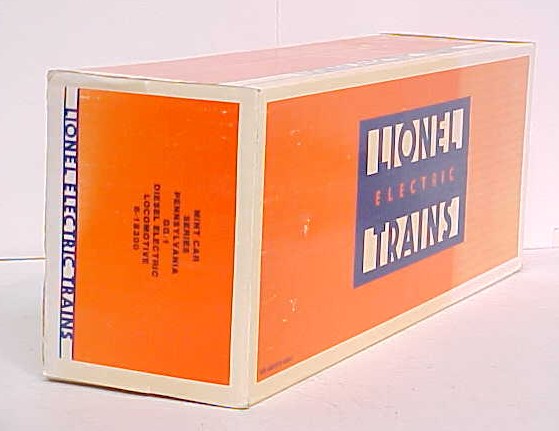
The original Postwar-Era GG-1s were packed in plain brown corrugated boxes with the number stamped on the ends. The boxes have an inner liner to hold the engines in place, with decorated brown paper wrapped around the engine itself. The boxes have been reproduced, so care is needed to ensure that the box is original when paying the price for an authentic box.
The MPC-era GG-1s were all packed in rather oversized boxes with pictures of the engine on the sides and ends. The boxes have Styrofoam liners and with plastic bags to protect the engines.
Early Modern-Era GG-1s [18300, 18303, 18308 and 18313] came in orange and blue Lionel boxes designed to replicate the original Lionel boxes of the 1950s. This is ironic, considering the Postwar GG-1s were never packed in orange and blue boxes. These boxes were the same dimensions as the MPC-era boxes and had the same Styrofoam interiors.
The #18314 Century Club GG-1 was packed in a special blue outer box, with the orange and blue box inside of it. It was also shipped along with the matching display case in a large shipping carton.
The Postwar-Celebration GG-1s have boxes like the ones used on early Modern-Era GG-1s, but they have the special Postwar Celebration markings, and the outer boxes are not as thick and sturdy as those used previously.
The new Conventional Classics GG-1s are packed in boxes reminiscent of the original Postwar boxes. They are plain brown on the outside with an inner liner and plastic to wrap around the engine.
All GG-1s were originally shipped with instruction sheets. Postwar-Era Gs have instruction sheets unique to their model number, while the MPC, Modern-Era and Joshua Lionel Cowen engines use a generic instruction sheet that was packed with all GG-1s in their series. The #18314 also included a certificate of authenticity and original blueprints of the model.
Conclusion
For over 60 years, the GG-1 has been at the top of Lionel's locomotive offerings. The G's fierce power and still-modern looks have made it a favorite for many collectors.
The only challenge Lionel and other O Gauge train makers face is to avoid repeating themselves. Lionel has now made the five stripe GG-1 in twelve different model numbers since '47, and the alternative road names like Penn Central and Amtrak did not sell well. But the success of the Conventional Classic GG-1s show that enthusiasm for the engines remain strong, and we are sure to see more of these sleek classics in the future.
Additional Information
--The Standard Catalog of Lionel Trains, 1945-69 , by David Doyle. A comprehensive guide to Postwar Lionel. Lots of pictures and information.
--The Standard Catalog of Lionel Trains, 1970-2000 , by David Doyle. A complete treatment of the MPC era and the early Modern Era. Terrific source of information and reference.
Acknowledgements
Much of the information in this article was obtained through observations here at Trainz.com. Lionel's catalog listings were of great help as well.
Alvin Staufer's Pennsy Power [c.1962] and Pennsy Power II [1968] were a great source of historic information on the GG-1s, as was the GG-1 reference page on www.wikipedia.com.
Tommy Feldman
General Manager, Trainz.com


